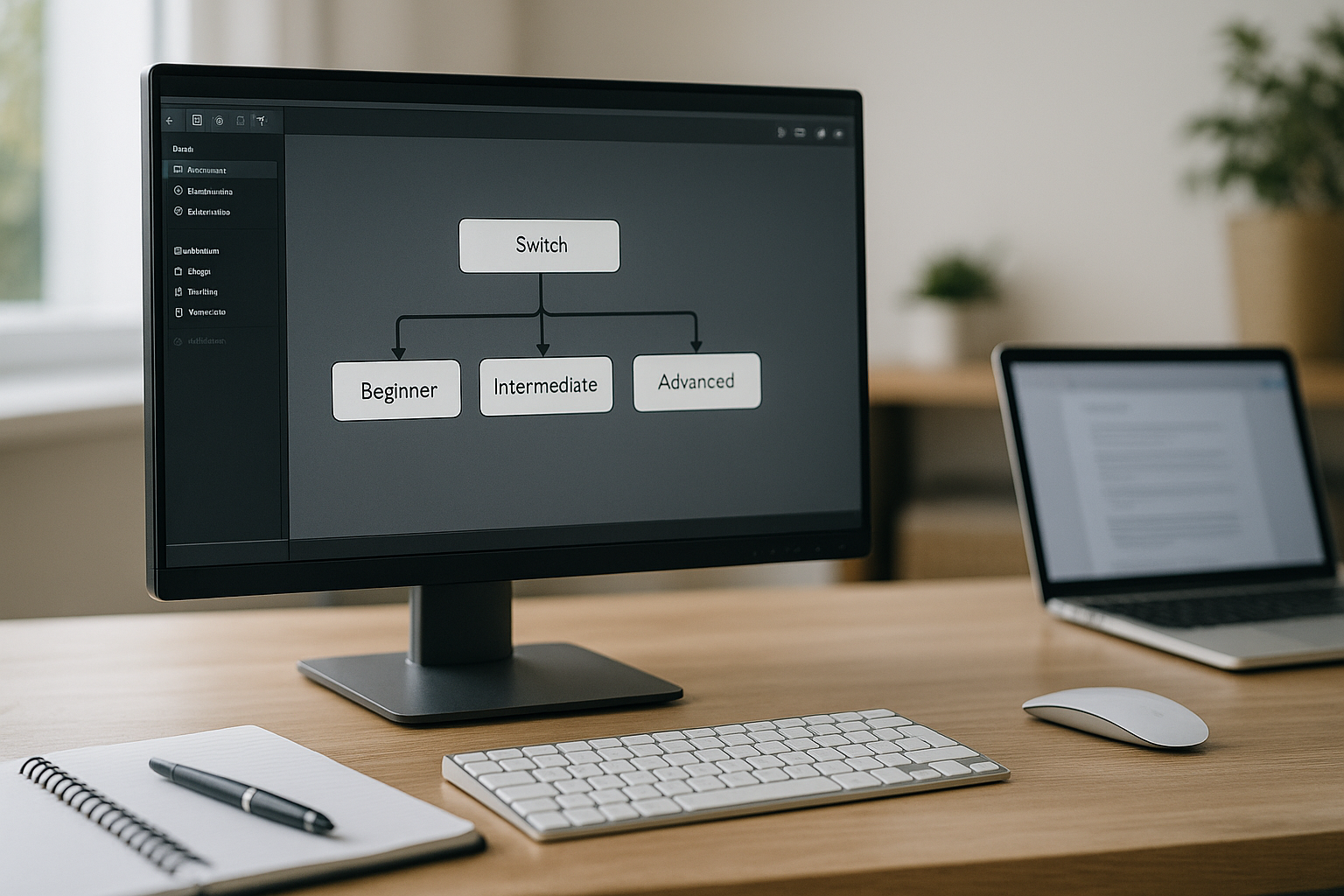Switch E-Learning Block: Simplify Your Learning Paths with Logical Branching
You manage a training catalog and need to adapt content based on user profiles, levels, and results—without turning your flowchart into spaghetti. The Switch E-Learning Block in VTS Editor is the perfect routing tool: it replaces a cascade of conditions with a central decision node, enabling clear, easy-to-maintain, and truly adaptive learning paths while remaining SCORM-compatible and LMS trackable. To discover the authoring tool, visit the VTS Editor page.
Why Use the Switch E-Learning Block in VTS Editor?
- Readability: a single routing node replaces a chain of Condition blocks.
- Maintenance: adjust one expression and a number of exits—not dozens of links.
- Fewer Errors: the default output serves as a safeguard directing to help or a hub.
- Performance: fewer blocks and verifications, better reuse.
Clearer learning paths also help reduce learners’ cognitive load, which can improve comprehension and retention. See the summary on Cognitive Load Theory.
How the E-Learning Switch Works
The Switch reads an expression that returns an integer. If the expression evaluates to 1, output 1 is triggered; if it’s 2, output 2; and so on up to N. If the value is out of bounds (< 1 or > N), the final output serves as the default exit. In practice, normalize your logic (score, choice, profile) to a value between 1 and N, and let the block handle the routing.
Quick Example
Let’s say difficulty level is calculated from a score out of 100:
band = floor(globalScore/20)returns 0 to 5level = clamp(band, 0, 2) + 1returns 1 to 3- Max Value: 3
If level equals 1: output 1 (Beginner); 2: output 2 (Intermediate); 3: output 3 (Advanced). If by mistake the variable is 7, the default output takes over.
Key Configuration and Best Practices
- Two key fields: the Expression for Output Number (must return an integer) and the Maximum Value.
- Clarify intent in the block note (routeIndex = floor(globalScore/20)+1; max=3).
- Test edge cases: 0, 1, N, N+1.
- Clearly rename target blocks (Chapter_1_Beginner, Chapter_2_Intermediate).
- Centralize the index computation (Variable block or reusable Function).
Switch vs Conditions, Random, Sequence
- Conditions: useful for complex comparisons (>, <, AND/OR). If you’re chaining n == 1, n == 2…, Switch is better.
- Random: serves randomness; combined with Switch, you draw a number and route it cleanly.
- Sequence: for fixed order (1, 2, 3… then back to 1). If the order depends on a calculated state, use Switch.
Variables and Data Sources
Switch relies on a variable expression (included in the Integral subscription). Common sources: Score/Check Score, Flags, Menu/Choice/Quiz, language, URL parameters, countdown. Tip: normalize values to 1..N and centralize calculation via Function Call. To improve your skills with variables, check out the training VTS Editor – Introduction to Variables.
Default Output: Real Remediation
The default output isn’t a “trash bin.” Turn it into a support strategy: redirect to a hub, display a clear message, open a key resource, or launch a mini-quiz. Log the event with Recap (Fallback Switch – unexpected value = {routeIndex}) to understand what went wrong.
Real-World Use Cases for E-Learning Branching
Routing by Score or Skills
At the end of a quiz, compute a band (1..3) and let Switch route to the right sequence:
- Beginner: reminders and guided role play.
- Intermediate: semi-open client case with feedback.
- Advanced: simulation with tough objections.
Add Progress for SCORM reporting and Badges to reward each level. Gamification boosts engagement—see the meta-analysis by Sailer & Homner (2020) The Effects of Gamification on Learning. Get inspired by real-world examples from our client cases.
Modular Navigation and Dynamic Chaptering
Give managers the freedom to choose a chapter without a star-shaped flow: capture the selection via Menu, store chapterIndex, and route using Switch to Chapter 1/2/3. Advantage: readability and easy to add a chapter (just add one output). To build this type of content, check out our gamified e-learning modules.
Controlled Randomization and Replayability
For case studies, use Random to draw a number between 1..N (option “one output only once”), then route with Switch. You confine randomness to the selection, maintain a clean architecture, and log the case drawn for your stats.
Customization by Profile, Language, or Device
Combine language, profile flags (manager/sales/technical), and URL parameters (level=2) to generate a unique index. Switch directs to the right content with appropriate media and difficulty. Speed up production with Variable Media. For seamless deployment and detailed tracking, discover our LMS VTS Perform. To learn more about adaptive learning, see EDUCAUSE’s overview: Adaptive Learning.
Remediation and Support Paths
After several failed attempts (via Counter), switch routeIndex to a “Support” branch that launches a slideshow, accesses a key resource, and features a mini-quiz. Adjust Score and Progress to maintain clean reporting in your LMS. For compliance, see the SCORM standard (ADL): SCORM – ADL.
Step-by-Step Implementation in VTS Editor
Prepare the Routing Expression
- Clearly name your variable (routeIndex, level, chapterIndex) and note its origin (score, choice, profile, language, random).
- Normalize values to 1..N with
clamp()to avoid overflows. - Initialize early in the scenario (using the Variable block) and use the Tests window to quickly simulate cases.
Map Outputs and Build the Paths
- Assign each output a clear objective, dedicated media, and a consistent entry point.
- Prepare a useful “fallback”—not a dead end.
- Create reusable templates per level (Beginner/Intermediate/Advanced) to save time.
Winning Combinations with Other Blocks
- Switch + Counter: progressive help (hint, demo, full support).
- Switch + Random: controlled drawing of case studies, tidy architecture.
- Switch + Check Flags: enforce prerequisites (e.g., tutorial viewed) before continuing.
- Switch + Progress: accurately set progress, completion, and success.
- Switch + Function Call: factorize briefings, instructions, debriefs, feedback.
Testing, Debugging, and Robustness
- Always test 0, 1, N, N+1 to validate the default exit.
- Monitor variables in real time (Variable Status window).
- Trace routes with Recap (“Switch -> output 2 – Intermediate”).
- In case of unexpected branching, display a clear message and offer return to hub.
Performance, Readability, and Governance
- Replace chains of Conditions with a central Switch to reduce blocks.
- Structure the graph with named groups, a stable naming plan, and descriptive notes.
- Leave room to add future outputs.
- Document your expressions and centralize calculations in Functions to speed updates.
Key Questions from Training and HR Managers
Scalability and Update Time
- The Switch E-Learning Block helps you roll out the same learning structure across multiple profiles/regions without rewriting logic.
- Updating an expression or adding an output takes a few minutes—not hours.
Instructional Quality and LMS Reporting
- The default output prevents learner dead ends and offers guidance.
- Progress/Score data feeds reliable LMS reporting.
Total Cost of Ownership
- Fewer blocks and more reuse (Functions, Variable Media) = less technical debt.
- For large-scale deployment, rely on VTS Perform.
Take Action
Remember the essentials: e-learning routing through the Switch Block brings clarity, robustness, and easy evolution to your learning paths. Start with a three-output Switch plus one default exit; normalize your variables into the 1..N range; centralize your calculations; factor in shared elements; test your boundaries; refine your remediation.
Need help structuring your branching scenarios at scale? Our teams can support you:
- Explore the tool: VTS Editor
- Get trained: Introduction to Variables and Advanced Gamification
- Deploy at scale: VTS Perform LMS Platform
- See real results: Thales Client Case
Ready to simplify your learning paths with the Switch E-Learning Block? Request a demo or try the VTS suite free for 30 days.










